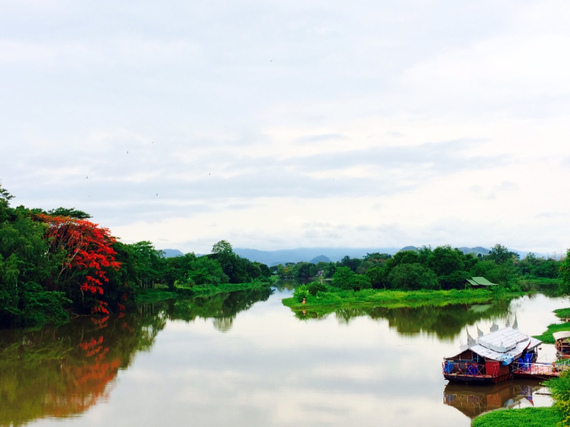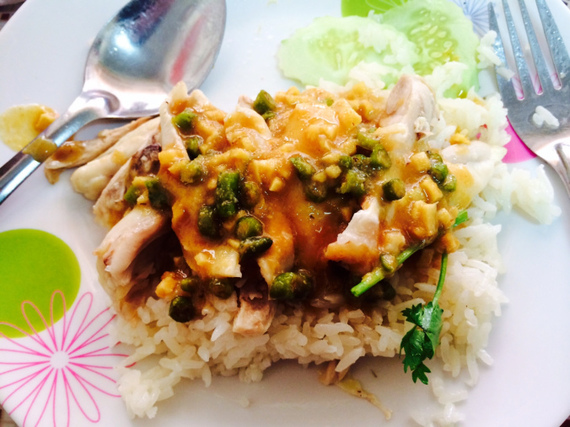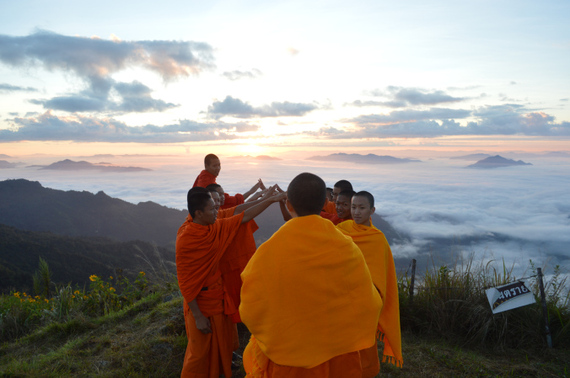Chiang Rai in the Media
Neda is Helping Thailand
Neda was established in 2005 -Neda president Acksiri Buranasiri joins residents of Muang Ngeun at the inauguration of the Thaifinanced road.
Neda was established in 2005 with the aim of helping neighboring countries in terms of trade, investment, land, sea and air transport networks, tourism and human resource development.
A public agency under the Finance Ministry, Neda, formerly the NEDF (Neighboring Countries Economic Development Fund), has from the start granted financial assistance, soft loans and technical support worth 9.42 billion baht to 23 projects, mainly for infrastructure development in neighboring countries.
Fourteen percent of the total has been financial aid, largely to Laos.
Major projects include the now-completed Chiang Rai-Kunming via Lao PDR Road Improvement Project (Highway 3), the Wattay International Airport Improvement Project in Laos, the Pakse Airport Improvement Project in Laos, a railroad construction project from northeastern Thailand’s Nong Khai province to Ban Thanaleng near Vientiane, drainage pipeline construction and Asian Highway improvement projects in Vientiane, the Huay Kon-Muang Ngeun-Pak Beng Road Improvement Project.
Neda also provided a 1.3-billion-baht soft loan to Cambodia to improve a 131-kilometre section of Highway 67 connecting Si Sa Ket’s Chong Sa-ngam border checkpoint with Cambodia’s Siem Reap province, home to the popular tourist destinations of Angkor Wat and Angkor Thom.
Neda had agreed to provide a one-billion-baht soft loan to Cambodia for the route from Surin’s Chong Jom border checkpoint to Siem Reap, but the deal fell through amid increased tensions between the two countries, so financing fell to the Chinese government instead.
“Our focus is all on basic infrastructure, mainly for road, water and electricity improvements that will help produce mutual benefits, be it for border trade, investment and tourism,” said president Acksiri Buranasiri. “Our ultimate goal is to create an economic corridor, as well as a transport corridor, for Thailand and its neighbors.”
Mr Acksiri insists Neda projects will not duplicate the work of other donors such as the Asian Development Bank, the World Bank, the Japan International Cooperation Agency or Chinese or South Korean agencies that generally participate in development projects on a much larger investment scale.
Neda’s financial assistance contracts stipulate the recipient countries must hire Thai subcontractors and consultants. For joint ventures, Thai firms must be the principal partners.
“At least half the financial assistance must be used to procure goods and services originating in Thailand,” said Mr Acksiri.
He said project completions would help to connect logistics systems across the region, which will help to promote Thailand’s economic growth by enhancing the potential of tourism, trade and investment.
This will especially help to improve the competitiveness of Thai entrepreneurs wanting to expand abroad, said Mr Acksiri.
Thailand, the third-largest foreign investor in Laos after Vietnam and China, funded 276 projects worth US$2.68 billion from 2000-10.
Border trade between Thailand and Laos was valued at 87.2 billion baht last year, with Thai exports worth 64.1 billion and imports worth 23.1 billion.
Shipments through Nan’s Huay Kon border checkpoint alone totaled 872 million baht _ 549 million baht for Thai exports and 323 million for imports.
“The 52-km Huay Kon-Muang Nguen-Pak Beng Road, which opened officially for traffic in July 2010, will not only help to increase border trade and tourism between the two countries, but also facilitate the transport network between northern Thai provinces, particularly Nan, with the northern provinces of Laos, especially through Muang Nguen of Sainyabuli province and Pak Beng of Oudomxai province. It will serve as a strategic route connecting Thailand and Laos with other countries in the sub-region via Highway 2 in Laos to Dien Bien Phu in Vietnam in the future.”
Mr Acksiri said Neda is considering 18 development programs worth a combined 8 billion baht, mostly in Laos.
Plans are also afoot to seek cabinet approval to extend coverage to East Timor, Sri Lanka and Bhutan, where Neda foresees great potential for infrastructure development.
“Given our experiences and growing assets and cash, now estimated at a combined 10.5 billion baht, Neda is building up its credibility so it can raise funds to support its own lending schemes apart from the 500 million baht the government allocates each year,” said Mr Acksiri.
“A bond issue, probably backed by the Finance Ministry, is highly likely in the near future.”

Chiang Rai in the Media
Three Must-Visit Places in Chiang Rai

–
CHIANG RAI – Situated in the northern part of Thailand, Chiang Rai slips under the radar of tourists as the area is not as popular as its neighboring city Chiang Mai.
However, Chiang Rai actually offers one-of-a-kind attractions, varying from a majestic white temple to Akha tribe tradition, which cannot be found anywhere else.
Those wanting to know more about Chiang Rai may consult the list below:
Wat Rong Khun (White Temple)

Pha Mee village
Located in Mae Sai district, Pha Mee village is home to the Akha hill tribe. In the past, the village was known as an opium producer and conflict area. However, with the help from the late King Rama IX, Pha Mee has transformed into a peaceful village.
During Asean Travel Journo Camp – a nine-day trip organized by Thai Journalists Association and Thai AirAsia to commemorate the 50th anniversary of Association of Southeast Asian Nations – The Jakarta Post discovered that the tribe recently developed a community-based tourism program, allowing tourists to catch a glimpse of their daily lives through various activities.
By contacting local guides such as Local Alike or go to the Pha Mee directly, tourists can expect to learn about Akha hill tribe tradition, the village history, sample the local Arabica coffee or hop on the village’s giant swing.

Singha Park
Singha is recognized as a Thai beer producer. However, in Singha Park, visitors would not see brewery or the likes, but instead a picturesque oolong tea plantation.
Meanwhile, tucked inside the park, the Phu Phi Lom restaurant is ready to satisfy your taste buds with Northern Thai delicacies.
By Jessicha Valentina
The Jakarta Post
Chiang Rai in the Media
Learning Akha hill tribe’s way of living in Pha Mee village

Two villagers pulled my seat and I screamed at the top of my lungs as the cool breeze hits my cheeks.
CHIANG RAI – The Akha’s giant swing, located on the hill of Pha Mee village in Mae Sai district, Chiang Rai, Thailand, was made of woods, ropes and tire. No safety equipment was seen around the swing, only a villager controlling one rope on the side.
Our guide, who is also Local Alike sustainable tourism initiator, Bow Pongnin, ensured us the swing is safe, explaining that it has been a tradition in the village for men to remove the wooden seat and swing as high as they could to prove their manhood.
I felt excited when seeing Pongnin and two Akha natives hopped on the swing. After they were done, I raised my hand, wanting to try it too, of course with a seat on.
As I walked towards the giant swing, I could see the bear-shaped mountains, reminding me of Akha tribe community leader Pho Luang’s story that Pha Mee village’s name was derived from the shape.
I climbed the seat and hold on the rope tightly. Two villagers pulled my seat and I screamed at the top of my lungs as the cool breeze hits my cheeks. I tried to keep my eyes open to make sure I would not fall down the hill as well as to record the breathtaking views on my mind.
After a while, I asked the villager to stop the swing. I felt fortunate as I landed on the ground, fully intact.

The giant swing is not merely for entertainment, but a part of Akha tribe traditions I learned during Asean Travel Journo Camp, an event initiated by Thai Journalists Association and Thai AirAsia.
Though the appearance looked decent, the giant swing plays a crucial role in the life of Akha people, indigenous tribe living in the northern part of Thailand.
In addition to a place for the men to show their manhood, the giant swing’s area is a central spot during Akha’s New Year. In fact, it is considered sacred as visitors are not allowed to look back while entering the gate. “They believe it is going to give bad luck,” said Pongnin.
After trying the giant swing, Pongnin and Pha Mee Community Tourism Enterprise vice president Phakakarn Rongpracharat brought us to a wooden lodge, explaining the community relationship with Thailand former King Rama IX.

Nowadays, Akha tribe grows coffee for a living. However, it was not always the case. Back in the early 1970s, the villagers produced opium to make ends meet.
Opium production was not the only issue. Pha Mee village is located a stone’s throw away from Myanmar border and conflicts happened frequently, making some of the villagers wanted to move from the area.
Fortunately, with the help of King Rama IX, Pha Mee has become a livable peaceful village. The King was said to study the area and suggest them to grow coffee, a tradition they still keep up to this day.
Though peace has come to the village, some people still associated Pha Mee with drugs.
To change the negative image and promote the village, 30 members of the community worked hand-in-hand to develop community-based tourism program, starting from October last year.

Before landing on the giant swing, this tourism community brought us to catch a glimpse of their daily lives through several activities, such as weaving, making local snack, homecoming tradition and trying Akha traditional clothing that includes a five-kilogram silver headpiece. These activities were designed for tourists to learn more about their culture.
Rongpracharat told The Jakarta Post that they enjoy hosting people. “At first we did not have any idea how to start [the community-based tourism], but with the help from several organizations, such as AirAsia and Local Alike, they started to understand it,” she said.
She added that tourism activity had become one of the ways to preserve the tradition.
“Time has changed. Sometime, the children feel shy to wear their traditional Akha clothing. [Since we started the tourism program] the children began to feel proud [to wear the traditional clothing],” she explained.
After the entire activities were done, the community sent us back to our vans. We bid goodbye and, surprisingly, I felt a bit melancholy. In less than 12 hours, this community not only made me understand their traditions, but their hospitality made me, temporarily at least, feel as a part of them.
Jessicha Valentina
The Jakarta Post
Chiang Rai in the Media
How to Spend a Weekend in Chiang Rai
.
Chiang Rai is often compared to what Chiang Mai was like years ago before tourism boomed and saturated the local community. This Northeast Thailand gem sits within the heart of the Golden Triangle just a mere few hours from the borders of Laos and Myanmar and a scenic four hour bus ride through Doi Luang National Park from Chiang Mai.
Out of the way for most travelers, Chiang Rai has remained unspoiled by the robust influx of tourism. It boasts contemporary Asian urban flair with an artistic and hippie-esque ambiance while retaining Thai authenticity. I set down roots in Chiang Rai after backpacking around Southeast Asia for five months. You can get a taste of the small town expat life here and how the expats and locals have peacefully integrated, living side by side in harmony.
Before I moved to Chiang Rai, a spontaneous weekend visit while traveling was enough to make me fall in love with its quirky charm and creative vibes. What does a weekend in Chiang Rai look like? Sit back, close your eyes and take my hand. Let’s go on a Chiang Rai adventure.
First, we travel there on the back of an elephant…
Just kidding folks, I know riding elephants is a touchy subject; Chiang Rai has its own international airport if you’d rather fly. The popular option is to travel by bus from Chiang Mai. Purchase your ticket at the Green Bus counter in Arcade Bus Station. They have regular buses leaving throughout the day.
Transportation Tip: Renting a motorbike for the weekend allows the most freedom, but if you want to get around using local transportation, take the blue songthaews for 20-30 baht 50 cents- $1) per person.
WAKE UP. We’re in Chiang Rai! Let’s find a place to stay…
The bus station in Chiang Rai is located in the heart of the city center. You can find plenty of accommodation options at reasonable prices, whether you seek a dorm, guesthouse or hotel room. Here are my top recommendations:
Friends House Chook Dee: This is my ultimate hostel recommendation, conveniently located in the city center, just a 10 minute walk to the bus station. Chook Dee isn’t your typical Thailand hostel. The crew that runs the place have made it into a chill hangout where friends- whether local Thai regulars, expat regulars or backpackers gather to relax, drink and kick it. There are dorm and private rooms available.
Chian House: It’s tricky to find this teak wood Lanna style abode-turned-guesthouse, because it’s tucked away in a Thai neighborhood. There are soi dogs roaming the street, children playing, neighbors gossiping outside their homes and stores or they’re enjoying beers while watching football on TV. Chian has a quirky pack of guests- some are long term travelers, expats or weekenders. Nevertheless, everyone is family! They offer some tasty Thai and western fare enjoyed community style in the evening, a swimming pool and private rooms and bungalows.
I’m hungry, let’s eat
The dining options in Chiang Rai are diverse and delicious. Coconuts Bar may look like just a…well, bar…but you’d never guess that their curries are out of this world. The Panang curry is the best I’ve savored thus far, or any of the indian curries for that matter.
For both Thai and western dishes, especially brunch, Chivit Thamma Da is a MUST. Dress cute and bring your camera because the setting is like something out of a fairy tale. Sit outside the rustic, shabby chic style farmhouse along the tranquil Kok River and dig into their smoked salmon benedict on crispy potato pancakes. For dinner, get lost in the aromatic flavors of the North Thai pork curry and don’t forget to indulge in a creamy slice of homemade lemon cheesecake.
If you want some super tasty, cheap local Thai food then you need to visit this family run establishment. The khao man gai (chicken and rice) and tom yum soup are superb, all for around 40 baht ($2) a dish.
It’s Friday night, time to dance
Chiang Rai nightlife isn’t overrun by backpackers, elephant pants and face paint. On Jetyod Road, there is a string of bars with a mix of expats and locals. Peace House is a favorite for live music on Friday nights, where talented reggae band Croissant fills the air with the sweet sounds of Pink Floyd and Bob Marley. Peace House is as laid back as it gets, with a beautiful sitting garden for guests to enjoy drinks and socialize.
Let’s get out and explore
Chiang Rai is best known for the White Temple and Black House. Nationally recognized Thai artists showcase their eclectic architectural styles with earthbound renditions of heaven and hell.
If sightseeing isn’t your jam, nature reigns supreme on the city outskirts. Drive a motorbike into the mountains past rice paddies and trek through misty jungle to cleanse yourself in one of many gushing waterfalls. In Mae Salong the sprawling tea plantations offer breathtaking panoramic shots and just a couple of hours away, climb up into the heavens, where the village Phu Chi Fa sits far from the rest of the word. Wake early and witness a stunning sunrise from above the clouds.
Or, we can do some shopping
Saturday walking street in Chiang Rai isn’t a night market filled with cheap knock offs and Chang tank tops. The market is a weekend pastime enjoyed by the Thai community and visitors alike. City center streets are blocked off every Saturday evening and it seems like everyone in Chiang Rai is there. A Thai band plays traditional music (not 90s English covers) while Thais old and young enjoy dancing around the stage.
You’ll find one-of-a-kind arts and crafts for sale that you won’t see in other markets, and Chiang Rai is a thrifters paradise for trendy second hand clothing at cheap prices. I bought a dope pair of overalls for only 100 baht ($3)! The food vendors are plentiful, offering every Thai delicacy imaginable. Try the spicy som tum (papaya salad), North Thailand sausage and the small pancakes stuffed with tasty fillings such as Thai custard and fruit.
Want to learn more about my travels through Southeast Asia? Visit her travel blog: A Great Perhaps
-

 News3 years ago
News3 years agoLet’s Know About Ultra High Net Worth Individual
-
Entertainment2 years ago
Mabelle Prior: The Voice of Hope, Resilience, and Diversity Inspiring Generations
-

 Health3 years ago
Health3 years agoHow Much Ivermectin Should You Take?
-

 Tech2 years ago
Tech2 years agoTop Forex Brokers of 2023: Reviews and Analysis for Successful Trading
-

 Lifestyles3 years ago
Lifestyles3 years agoAries Soulmate Signs
-

 Movies2 years ago
Movies2 years agoWhat Should I Do If Disney Plus Keeps Logging Me Out of TV?
-

 Health3 years ago
Health3 years agoCan I Buy Ivermectin Without A Prescription in the USA?
-

 Learning2 years ago
Learning2 years agoVirtual Numbers: What Are They For?


